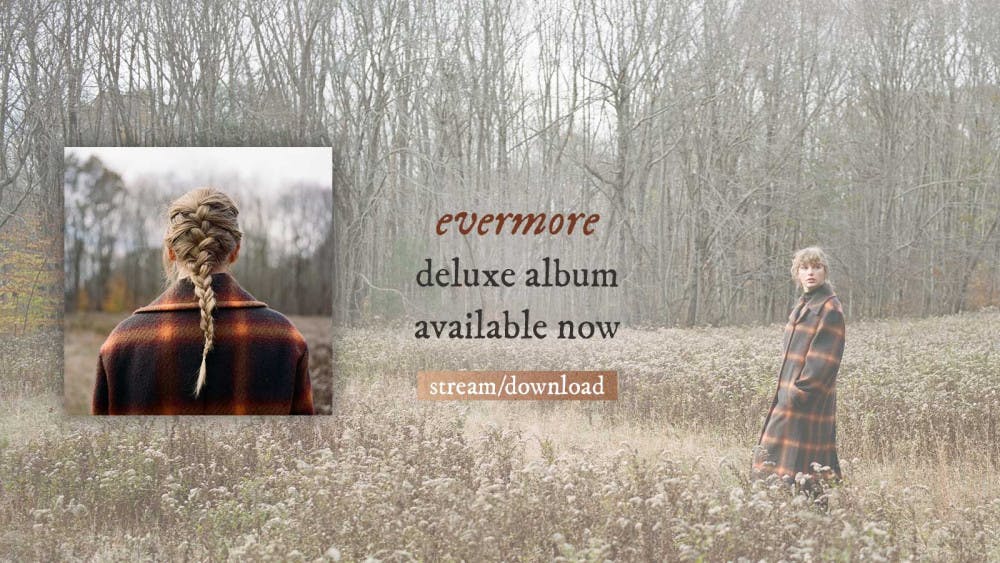She did it again.
Just when her fans thought she was all out of surprises, Taylor Swift decided to drop yet another 17 songs with almost no heads up. I guess we really shouldn’t be surprised. With all of the quarantining and free time, it only feels right that she would be expressing herself in some folk-pop lyrics for her millions of fans to enjoy.
The kindred but diverse set of tracks (her ninth studio album), titled Evermore, was released on December 11 and is regarded as an extension of Folklore, Swift’s album that was released more than five months prior. The 31-year-old singer-songwriter went as far as labeling it Folklore’s “sister album.”
It would be generous to label me a novice in music production, but something that I have a more proficient grasp on is how the album makes a young music fan feel. Spoiler alert: it’s truly an experience.
When I took a step back to actually decipher the nuts and bolts of the 17 songs, it’s clear that while it’s labeled Folklore’s “sister,” it has the intricacies and storytelling to be its mother. It is a far superior and far more mature album, and you can tell that Swift and her team were able to get even more creative after the warm reception of her last project.
This experimentation paid off in her vengeful indie/country hit “no body, no crime.” If Clint Eastwood and Sergio Leone want to team up to make a 2021-style spaghetti western, this might very well be the first song on the soundtrack. It has the allure of a murder and crime ballad, but with a grace and charm that is most certainly Bon Iver-esque. It can double as an unforgiving break-up tune if you so choose.
There are a series of coated storylines and resolutions throughout the project, one of them becoming evident in “Dorothea,” the eighth track. Swift appears to be portraying a famous woman who meanders back to her hometown and rekindles with a hometown love interest. Her male counterpart, while trying to persuade her to stay with him says, “You got shiny friends since you left town/A tiny screen’s the only place I see you now.”
Each song has its own individual relationship with relationships; a new conflict with each passing lyric. While Swift might have run out of her own relationship quarrels to express, she has certainly not run out of ideas for others to experience. The album’s tenth song, “Ivy,” sifts and maneuvers its way through a woman’s infidelity. Swift repeats the phrase “now I’m covered in you,” which indicates that the ivy is the guilt and hatred she has for herself and her act, seemingly draped all over her. This is an interesting juxtaposition, as ivy is usually used at weddings to signify fidelity and trust.
But, one of the songs stick out among the rest on the personal connection front. “Majorie” details Swift’s relationship with her grandmother, Marjorie Finley. She details the fact that she holds so much of her beloved grandmother inside of her, but she still had so much to learn from her. It perfectly signifies the loss of a loved one while not being able to extract all the love and lessons that you wanted from them. She states, “What died didn't stay dead/ You're alive, so alive/ Never be so polite, you forget your power/Never wield such power, you forget to be polite/And if I didn't know better/ I'd think you were listening to me now.”
In my humble and everchanging opinion, the track that takes the cake is “tolerate it.” While the production and layering might not be to the level of some of its peers, it makes up for it in its storytelling. Swift creates an image of isolation that all can take pieces to run and cry with. It has the most emotional triggers that can be related to various aspects of any life, which allows it to be one of the most repeatable songs on the album. If your style of loving another person has ever been misunderstood or not accepted by someone that you care deeply about, you’ll need to invest in a family size box of Kleenexes before you put your headphones in.
Evermore is Swift’s best album, not because she has the most radio hits or because it will win the most AMAs. It’s because she pushed herself to new heights, ones she can continue to build off of. These 17 songs weren’t just about relationships or break-ups, they were about conflict, resolution, learning from mistakes and one trait that is new to Swift’s emotional arsenal: forgiveness. It seems like both this album and folklore helped her heal to a certain extent, and it looks good on her. She has come a long way from all her “Bad Blood.”
Photo courtesy of Taylor Swift














